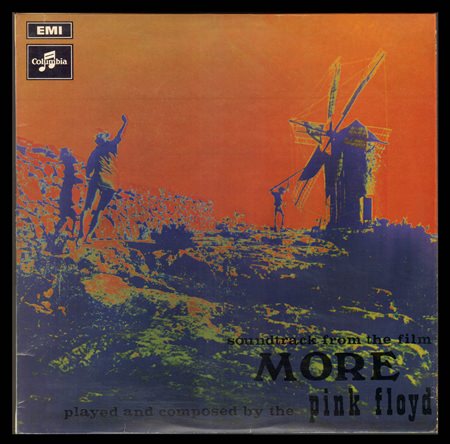
Pink Floyd: More (Columbia)
Pink Floyd went through a trial and error period after Syd Barrett imploded. Barrett still reverberated ghost-like through “A Saucerful Of Secrets”. And then they were on their own. The growing doubts about where to go must have troubled them. They were in demand as a live act but didn’t have a clue about their musical future. Where to go? What to do? Pink Floyd needed time.
The solution was movie soundtracks. There’s little risk and no pressure involved – except the deadlines. You’re just supposed to add musical structures to ready made visuals, there’s a storyline to follow and moods to capture, but all in all you are playing second fiddle. If the movie bombs it’s the director and the producers that go down, not you, you just provided the music.
So it was a very conscious move, during the years 1968-1970 Pink Floyd were involved in three movie projects; “The Committee”, “More” and “Zabriskie Point”. Of these only the “More”-recordings turned into a full-fledged Pink Floyd album. For the group “More” actually was the least risky of the three, a low-budget arty farty drugged out B-movie for hippies. They found themselves in a win/win-situation and took full advantage of it. Not surprisingly the music became considerably more famous than the cult movie it was supposed to accompany.
Without the pressures of having to create a follow-up to “Saucerful Of Secrets”, Pink Floyd was given the luxury of recording whatever they felt like playing, be it whimsical acoustic doodlings or heavy handed metal noise. It was movie music, they could do anything. Roger Waters’ leadership in the band began to take shape. He is largely responsible for the entire first side of the album. But the vibes during the sessions must have been very positive as Waters was generous enough to hand over all the vocals on the album to David Gilmour. Overall the music appears to be created by four individuals on a common mission. A collective.
The album contains a number of acoustic songs and melodies in the folk vein, a little drowsy perhaps, perfect stuff for a stoned brain on a sunny summer’s day. There are also several instrumentals where the band explores uncharted territory, but without getting too avant-garde about it. In addition, the album includes two of the heaviest recordings the group had done up to that point: “The Nile Song” and “Ibiza Bar”, both explosive rockers that should be played loud, volume turned up to 11.
Created without pressures and achieving an against all odds commercial success, “More” was exactly the recess Pink Floyd needed. It did not, however, make them any wiser regarding their musical future. The band’s next official release, “Ummagumma” (October 1969), was a live album offering weaker versions of key cuts from their Barrett/”Saucerful Of Secrets” phase and one studio album divided into four solo sections where all four lose themselves in some of the most self-indulgent drivel any famous rock group has ever put on vinyl. Four solo-albums on one record, and it all sounds like “More” on downers. The collective worked astonishingly well on “More”. Working separately they blew it big time.
Pink Floyd still had a long way to go before they touched down on “Meddle”.
Released: June 13, 1969
Produced by: Pink Floyd
(All vocals by David Gilmour)
Side One
1. “Cirrus Minor” (Waters) 5:18
2. “The Nile Song” (Waters) 3:26
3. “Crying Song” (Waters) 3:33
4. “Up the Khyber” (instrumental) (Mason/Wright) 2:12
5. “Green Is the Colour” (Waters) 2:58
6. “Cymbaline” (Waters) 4:50
7. “Party Sequence” (instrumental) (Waters/Wright/Gilmour/Mason) 1:07
Side Two
1. “Main Theme” (instrumental) (Waters/Wright/Gilmour/Mason) 5:27
2. “Ibiza Bar” Waters, Wright, (Gilmour/Mason) 3:19
3. “More Blues” (instrumental) (Waters/Wrigh/ Gilmour/Mason) 2:12
4. “Quicksilver” (instrumental) (Waters/Wright/Gilmour/Mason) 7:13
5. “A Spanish Piece” (Gilmour) 1:05
6. “Dramatic Theme” (instrumental) (Waters/Wright/Gilmour/Mason) 2:15
Personnel:
Roger Waters – bass guitar, guitar, tape and birdsong effects, bongos, gong.
Nick Mason – percussion, drums, bongos.
Richard Wright – Hammond and Farfisa organs, piano, vibraphone, bongos, backing vocals.
David Gilmour – acoustic, electric, slide, and Flamenco guitars, tape effects, bongos, lead vocals.
Additional Personnel:
Lindy Mason – tin whistle on “Green Is the Colour” and “Party Sequence”.
Hipgnosis – sleeve design.
 |
 |
 |





